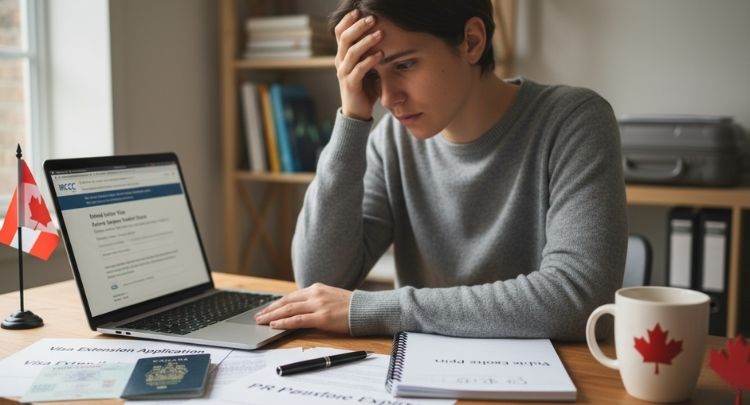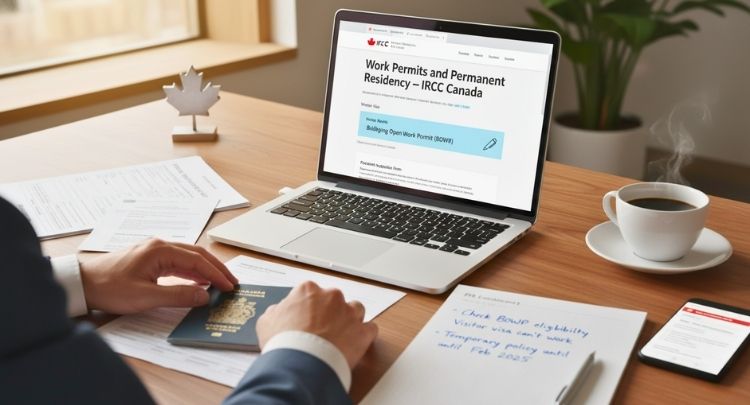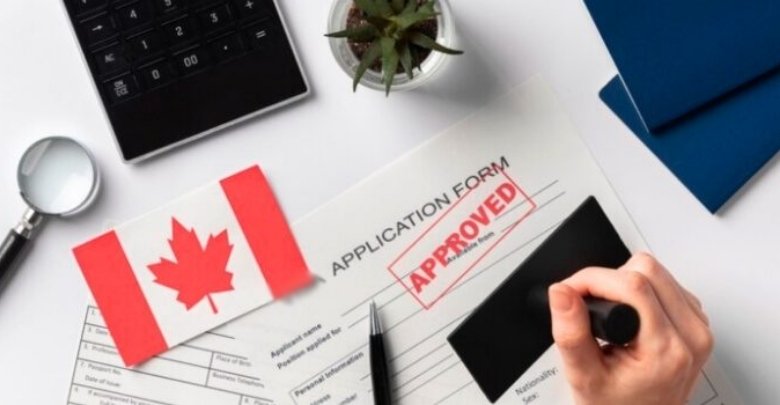Permanent residency in Canada is a dream for many visitors who fall in love with the country’s lifestyle and opportunities. People often begin as tourists and later wonder how they can stay longer or settle down for good. That’s when they start thinking about how to change a tourist visa to a permanent resident in Canada.
You cannot directly change a tourist visa to permanent residency in Canada. However, you can apply for PR by qualifying through programs like Express Entry, the Provincial Nominee Program, or the Canadian Experience Class. This usually requires a job offer, work permit, or Canadian work experience first.
Many visitors become curious about turning their short stay into something lasting. If you’ve ever thought about building a life in Canada, this article explains every important step. You’ll find clear guidance, from keeping legal status to applying for PR through the right program, all explained in simple detail.
What a Tourist Visa Really Allows in Canada?
A visitor visa lets you travel across Canada for tourism, family visits, or short stays. You can enjoy local attractions, meet relatives, and explore cities freely. It’s made for leisure purposes only, so always follow the visa rules during your visit to avoid any issues.
You cannot work or study in Canada with a visitor visa, even if it’s a short task. For example, if you’re planning to attend upcoming conferences in Canada, you can only join as a guest, not as a paid participant. The visa does not allow employment or study activities of any kind.
If your visitor visa expires but you already applied for an extension, you may receive maintained status. This means you can stay in Canada legally until a decision is made. Always keep your documents updated and check IRCC guidelines to avoid overstaying or legal problems.
How to Change a Tourist Visa to a Permanent Resident in Canada?
Many people visit Canada and later decide to make it their permanent home. Turning a visitor visa into permanent residency takes time and planning. You need to qualify under a federal or provincial immigration program. Read below to see the main ways to apply for PR from inside Canada.
Understand the Rule
You cannot directly turn a tourist visa into permanent residency. Canada allows visitors to apply for PR only if they meet specific program requirements. To start the process, applicants must qualify through federal programs, provincial nominations, or skilled work pathways recognized by the government. For official details and updated eligibility rules, always check the Government of Canada immigration pages to make sure you follow the right process and meet all necessary conditions.
Express Entry Pathway
This is one of the fastest and most common ways to apply for PR. It includes three main programs: Federal Skilled Worker, Federal Skilled Trades, and Canadian Experience Class. You must create a profile, earn a good score, and receive an Invitation to Apply (ITA) from IRCC.
Canadian Experience Class (CEC)
This program suits those who have recent Canadian work experience. Many visitors first switch to a valid work permit before applying. Having work experience in Canada shows that you can adjust to local jobs and communities, which improves your PR chances.
Provincial Nominee Program (PNP)
Provinces and territories in Canada select skilled people based on local job needs. You can apply directly to a province or get an invitation through Express Entry. A nomination from any province gives you extra points and a higher chance of getting permanent residency approval.
Secure a Job Offer
Having a valid job offer increases your eligibility for several PR programs. Many Canadian employers support work permit applications, allowing you to work legally. Once you gain local job experience, it becomes easier to qualify for programs like CEC or certain PNP options.
Apply for a Work Permit
When you get a job offer, apply for a work permit from within Canada if eligible. Working legally helps you build experience that supports your PR application. Make sure your job and employer meet IRCC requirements to avoid rejection during review.
Create an Express Entry Profile
Once you are eligible, open your profile in the IRCC system. Add all required information such as your job, education, and test results. Your profile gets ranked under the points system, and if you score well, you may receive an ITA to apply for PR.
Submit Your PR Application
After receiving your ITA, you can apply online using the Permanent Residence Portal. Upload your documents, including proof of work, education, and funds. Once IRCC reviews and approves your file, you can officially move from visitor status to permanent resident in Canada.
Sample PR Application
[Your Full Name]
[Your Current Address in Canada]
[City, Province, Postal Code]
[Email Address]
[Phone Number]Date: [Insert Date]
To:
Immigration, Refugees and Citizenship Canada (IRCC)
[Office Address, if applicable]Subject: Application for Permanent Residence from Visitor Visa
Dear Officer,
I am writing to formally apply for Permanent Residence in Canada. I am currently staying in Canada on a Visitor Visa, and I wish to apply for PR based on my [mention your category — for example: spousal sponsorship, Canadian work experience, study, or humanitarian grounds].
I have enjoyed my stay in Canada and have come to appreciate the country’s culture, diversity, and values. I believe I can contribute positively to the community and the economy. I have attached all the necessary documents to support my application, including:
- A copy of my Visitor Visa and passport
- Proof of my current status in Canada
- [Add other documents such as proof of relationship, employment, education, or financial stability]
I kindly request that my application be considered for permanent residence. I am ready to provide any additional documents or attend an interview if required.
Thank you for taking the time to review my application. I look forward to a positive response.
Sincerely,
[Your Full Name]
[Signature, if printed copy]
Becoming a permanent resident from a visitor visa in Canada takes patience and effort. Always choose the right immigration program for your case. Keep your documents ready, check your eligibility carefully, and submit your PR application correctly. With the right steps, you can start your new life in Canada confidently.
Checklist: Steps for Visitors Planning to Apply for PR in Canada
People often feel lost when they plan for PR in Canada. Many try to understand each step but still miss key parts needed. Clear guidance can help people avoid small mistakes during this process. Follow this simple checklist to learn what to do next.
1. Confirm You Qualify for a PR Program
- Check if you meet the rules for Express Entry, PNP, Family Sponsorship, or another pathway.
- Make sure your age, education, work experience, and language scores match the program you want to apply for.
2. Gather All Required Documents
- Passport
- Language test results
- Educational Credential Assessment (if needed)
- Work experience letters
- Proof of funds
- Police certificates
- Any other documents your PR program requires
3. Take Your Language Test Early
- Book your English or French test (IELTS, CELPIP, TEF, etc.)
- Higher scores can improve your chance of being selected.
4. Create Your Express Entry Profile (If Using Express Entry)
- Enter all details correctly
- Check your CRS score
- Improve your score if needed
5. Look for Provincial Nominee Opportunities
- Check if any province is inviting applicants who are already inside Canada
- Follow the requirements for that province
6. Extend Your Visitor Status if Needed
- Apply for a visitor record before your stay expires
- Keep your status legal while preparing your PR application
7. Do Not Work Without Permission
- Only apply for a work permit if you qualify
- Working illegally can harm your PR chances
8. Stay Ready for Medical Exams and Biometrics
- These are part of the PR application process
- Keep your documents updated
9. Submit Your PR Application Online
- Double-check all forms
- Upload complete and clear documents
- Pay the correct fees
10. Keep Checking Your IRCC Account
- Watch for messages
- Respond quickly to any requests
- Check for updates on your medical, background, or eligibility review
11. Plan for Processing Time
- PR applications take several months or longer
- Make sure you keep your visitor status valid during the wait
12. Stay Honest and Clear in Your Application
- Avoid adding false information
- Keep the story of your travel, education, and work consistent
- Mistakes can slow your file or cause refusal
What to Do if Your Visitor Visa Is Expiring While Preparing for PR in Canada?
When your visitor visa is about to expire while preparing for PR, it’s important to act quickly. Staying longer without legal status can create problems for your future plans. The good news is, Canada allows you to apply for an extension or restore your status. Read below to learn how to stay legal and safe.
How to Apply for a Visitor Visa Extension
If your visa is still valid, you can apply to extend your stay before it expires. This helps you continue living in Canada legally while you prepare your permanent residence documents. Below are the key steps to apply for a visitor visa extension.
Check Your Visa Expiry Date
Before doing anything, check the expiry date on your visa stamp or visitor record. Make sure to apply at least 30 days before it expires. Acting early gives IRCC time to review your application and prevents losing your temporary status.
Prepare Required Documents
You’ll need your passport, current visa copy, proof of funds, and a short explanation of why you want to stay longer. Make sure all files are clear and recent. Incomplete or unclear documents often cause long processing delays.
Apply Online Through IRCC
Log in to your IRCC account and find the option for extending your visitor status. Fill in all the details carefully and upload your documents. Once submitted, you’ll get confirmation that IRCC received your request.
Wait for the Decision
After applying, you can stay in Canada under “implied status” until IRCC decides. This means you are still legal even if your visa expires during the process. Keep checking your account for any updates or messages.
Plan Ahead if Extension Is Denied
If IRCC refuses your extension, you’ll have to leave Canada or apply to restore your status. Always prepare a backup plan early. If your visa is close to expiry, you can either apply for an extension or plan to depart Canada after your visit before your status becomes invalid, ensuring you maintain compliance while preparing your PR documents.
How to Restore Your Status if It Already Expired
If your visitor visa has already expired, don’t panic. Canada gives a short period to fix your status. You can apply for restoration within a specific time frame and continue your PR preparation while staying legal.
Understand Restoration Rules
If your visa has already expired, you may still have 90 days to restore your visitor status. During this time, you cannot work or study. You must apply online with a restoration request form.
Collect All Required Proof
Include your passport, old visa copy, proof of funds, and an explanation for missing your renewal date. A clear reason increases your approval chance. Common valid reasons include delays in PR document collection or medical issues.
Submit Your Application Online
Use the IRCC portal to submit the restoration request. Choose “restore temporary resident status as a visitor” and follow the instructions. Pay the required restoration and visa fees in one payment to avoid rejection.
Avoid Traveling Outside Canada
While waiting for a decision, you cannot leave and re-enter Canada. Doing so may cancel your restoration process. Stay inside the country until you receive official approval or status confirmation from IRCC.
Check Processing Updates
It can take several weeks for IRCC to decide. You’ll get email updates when your file moves forward. Keep your account active and respond quickly if the office requests more documents or clarification.
Risks of Overstaying in Canada
Some visitors forget to renew their status or overstay by accident. Overstaying can cause serious issues for your current visa and future applications. Knowing the risks helps you make the right decision and protect your immigration record.
Legal Problems After Expiry
If you stay past your visa expiry without applying for renewal or restoration, your status becomes illegal. This can lead to deportation, fines, or future visa bans. Always act before your visa expires to stay safe.
Impact on Future Applications
Overstaying affects future visa or PR applications. IRCC keeps track of your status history. A record of unlawful stay can lower your chance of approval for any Canadian visa or permit later.
Possible Loss of PR Eligibility
Even if you qualify for PR, an overstay can hurt your application. Officers may question your respect for immigration laws. Keeping your stay legal shows good intent and helps your PR case.
Problems With Travel or Employment
Without valid status, you cannot legally work or travel within Canada. Airlines and employers check immigration documents. Staying without valid status puts you at risk of being denied travel or job opportunities.
How to Stay on the Safe Side
Always keep your visa valid and check expiry dates early. Use your IRCC account to apply on time. Avoid risky delays that can affect your legal stay and PR application in the future.
Managing your visitor status while working on PR is very important. Always check expiry dates and act early to avoid problems. Applying for extensions or restoring status keeps your record clean. Stay alert, follow official IRCC steps, and your PR process will go more smoothly.
Can a Visitor Work in Canada While Applying for PR? (Rules Explained)
Working in Canada while holding a visitor visa is not normally allowed. A visitor visa only lets you stay for tourism, family visits, or short-term stays. To work legally, you must first have a valid work permit. However, there are a few exceptions and special programs that let certain applicants continue working while waiting for permanent residency.
Key Rules to Remember:
- A visitor visa does not give permission to work or study in Canada.
- You must apply for and receive a valid work permit before starting any job.
- Working without authorization can harm your permanent residency application later.
- Visitors cannot simply “convert” their visa into a work permit or PR status.
- Always wait for official approval before beginning work to avoid legal problems.
Exceptions and Temporary Options:
- Bridging Open Work Permit (BOWP): If you’ve already applied for PR and currently hold a valid work permit (or recently held one), you can apply for a BOWP to keep working legally while waiting for your PR result.
- Temporary Policy (Until Feb 28, 2025): The Canadian government has extended a policy that allows certain visitors who held a work permit in the past 12 months to apply for a new one from inside Canada.
- This policy lets them get interim work authorization faster, meaning they can begin working while their new permit is processed instead of leaving the country.
In Simple Terms:
- You cannot legally work in Canada with a visitor visa alone.
- You must apply for a work permit, such as a BOWP if eligible.
- The special visitor policy active until February 2025 gives limited in-Canada options for some applicants.
- Always check the latest rules on the official IRCC website before applying.
PR Processing Times for Visitors in Canada (2026 Update)
If you’re in Canada on a visitor visa and planning to apply for permanent residency, knowing the latest processing times helps you plan better. Timelines can vary based on the program you choose and how complete your application is. Below are updated 2026 estimates for major PR routes.
Express Entry Timeframes
Express Entry remains one of the fastest ways to get permanent residency in Canada. It includes programs like the Canadian Experience Class (CEC) and the Federal Skilled Worker Program (FSWP). Most applicants with complete documents receive a decision in a few months.
Average Processing Time
For most Express Entry applications, it takes about 5–6 months from when IRCC receives a complete file. Some reports show it may take 6–8 months in real-world cases depending on application volume or security checks.
Why It’s Faster
Express Entry is a digital system designed to handle skilled-worker files quickly. Since everything is submitted online, there’s less paper handling and faster communication with officers. You can learn more about the process and eligibility on the IRCC Express Entry page for the most accurate and current details.
What Affects the Timing
Delays usually happen if medical or background checks take longer. Incomplete files or unclear employment history can also slow things down. Keeping your information accurate and up to date helps you avoid long waits.
Common Tip for Applicants
Make sure to double-check your documents before submitting. Use your IRCC account to upload forms correctly and pay all required fees in one go. These small steps help keep your processing time on track.
Provincial Nominee Program (PNP) Timeframes
PNP timelines depend on whether you apply through an Express-Entry-aligned stream or a base (non-Express Entry) stream. Each province sets its own pace based on demand and available immigration spots for the year.
Enhanced (Express Entry-Aligned) Streams
Applicants using an enhanced or Express Entry-aligned PNP can expect processing times of around 6–7 months once their file reaches IRCC. This path is faster since it uses the digital Express Entry system for final PR steps.
Base (Non-Express Entry) Streams
For base or non-Express Entry PNP streams, it usually takes 16–19 months. These cases often involve more paperwork and manual review by both the province and IRCC, which naturally increases the waiting period.
Why Timelines Differ
Express-Entry-aligned applications move faster because they go through automated digital checks and streamlined document sharing. Base streams still depend on paper-based handling and additional reviews by provincial officers before federal approval.
Tips for Faster Results
Submit all provincial nomination documents correctly and avoid missing signatures or outdated forms. Staying in contact with your province’s nominee office helps you respond fast if they request extra details.
Family Sponsorship Timeframes
Family sponsorship cases are usually slower because of high demand and multiple review stages. Timelines also vary depending on whether you apply from inside or outside Canada and the province you live in.
Spouse or Partner (Outside Canada)
Typical processing time is about 13–15 months for applicants living outside Canada (non-Québec). These cases include background and relationship verification steps that can extend the timeline.
Spouse or Partner (Inside Canada)
Inland sponsorship cases take longer, around 22–24 months on average. These applications move slower because applicants are already in Canada and undergo additional eligibility checks before approval.
Québec and Other Special Cases
Applications linked to Québec often take three years or more. The province has its own rules, approval steps, and limited quotas, making the process slower than other regions.
Parents and Grandparents Sponsorship
This category takes the longest, usually 2–3.5 years, because of high demand and limited yearly invitations. Completeness of documents and background verification can also affect timing.
A Few Important Notes
Processing times are only averages, not guarantees. Some files move faster depending on workload, accuracy, and background checks. IRCC only starts processing once all required documents, medicals, and police certificates are submitted. Complicated cases or missing forms can cause long delays.
Knowing your PR processing time helps you plan your next steps in Canada wisely. Express Entry is generally the fastest route, while PNP and sponsorship streams take longer. Always send complete and updated documents to avoid unnecessary delays. Staying patient and checking your IRCC account often ensures you don’t miss any important updates.
Costs to Expect When Applying for PR From a Visitor Visa in Canada
When applying for permanent residence from a visitor visa in Canada, it’s important to plan your budget early. The total cost depends on how many people are included in your application. The table below shows the usual government fees in Canadian dollars for easy reference.
| Applicant Type / Fee Type | Processing Fee (CAD) | Right of Permanent Residence Fee (RPRF) (CAD) | Biometrics Fee (CAD) | Total Estimated Cost (CAD) |
| Single Adult Applicant | 950 | 575 | 85 | 1,610 |
| Adult + Spouse/Common-law Partner | 1,900 | 1,150 | 170 | 3,220 |
| Dependent Child | 260 | Not required | Usually included under family file | 260 per child |
Notes:
- Fees are paid in Canadian dollars (CAD) and may vary slightly depending on payment method.
- Biometrics are required only once every 10 years in most cases.
- Additional costs may apply for medical exams, police certificates, or document translations.
- Always check the latest fee updates on the official IRCC website before paying.
Real Examples: How Visitors Successfully Became Permanent Residents
Many visitors dream of staying in Canada for good one day. Some manage to do it legally by following the right steps and keeping a valid status. There are real stories that show how it can work out with effort and honesty. Read below to see how visitors became permanent residents in different ways.
Visitor → PR Through Express Entry
- Some people on a visitor visa decide: once they leave Canada (or while outside) they submit a complete Express Entry profile. Then, after receiving an Invitation to Apply (ITA), they submit for PR. A thread on one immigration forum notes: “the processing of a PR application can take anywhere from six months to well over a year.”
- Because you’re not working illegally as a visitor (just visiting), you avoid issues related to working without permit. After approval, you can land as a PR once you get your Confirmation of Permanent Residency (COPR).
What made this possible
- The applicant did not overstay or work illegally as a visitor, keeping status intact and honest.
- They had the right credentials: education, language ability, work experience from outside Canada — enough to qualify under Express Entry.
- They submitted a clean, full application with complete documents.
Visitor → PR Through Family Sponsorship (Spouse/Common-law / Partner)
- There are documented cases where someone visits Canada on a visitor visa, builds a genuine relationship (spouse or common-law), and later gets PR through sponsorship. One personal story describes obtaining PR via common-law sponsorship after living together and submitting the spousal/common-law route application.
- In that case, the applicant and their partner prepared proof of co-habitation and a genuine relationship — shared address, shared finances or bills, joint documentation, photos, etc.
What helped the case succeed
- A real and documented relationship that met the requirements for spousal/common-law sponsorship (not just pretending).
- Correct and full documentation to show genuine commitment — living together, shared finances, etc.
- Timely and accurate submission of the sponsorship application — with biometrics, medicals (if needed), and other required documents.
Visitor → Work Permit → PR (Then PR via Work-Permit Path)
This path is less well documented in public forums — but there are advice-type guides suggesting that visitors who manage to get a valid job offer may be able to convert to a work permit (if they meet criteria), then use that work experience to qualify under economic immigration or provincial streams, then apply for PR.
From forum posts:
“You can be a visitor in Canada and apply for PR — theoretically it’s possible.”
And some in Reddit community note complexities: if status lapses or you fall “out of status,” that can block PR through economic streams. For example:
“You cannot be approved for PR through an economic immigration stream if you are out of status in Canada.”
What made this possible (in successful or partially successful stories)
- The person got a job offer and converted visitor status to proper work-permit status (or another valid temporary status) — legally.
- After legally working for a certain time, they used that experience to qualify under the economic immigration stream (like Express Entry or a provincial program).
- They maintained valid immigration status throughout (visitor → work permit → PR application).
Commonly Asked Questions
Many people who visit Canada later wish to stay permanently but aren’t sure how the process really works. It’s normal to have questions about the rules, documents, and options available. Understanding the right steps can help you avoid mistakes and make your plan stronger. Below are some of the most common and important questions about how to change a tourist visa to a permanent resident in Canada.
Can I Apply For Permanent Residency While I’m Still On A Visitor Visa In Canada?
Yes, you can apply for permanent residency while in Canada, but you must qualify under an eligible immigration program. You cannot directly convert your visitor visa into PR status. You’ll need to apply under Express Entry, Provincial Nominee Program, or Family Sponsorship. Make sure your visitor status stays valid while your PR application is being processed.
Do I Need A Job Offer To Apply For Permanent Residency From A Visitor Visa?
Having a job offer is not always required but can help your PR application. A valid offer can earn you extra points in Express Entry or make you eligible for some provincial programs. If you don’t have a job, other factors like education and language test scores can help. Always check which stream fits your profile best before applying.
Can I Study In Canada While On A Visitor Visa And Waiting For PR?
No, you cannot study in Canada with a visitor visa alone. To study, you must apply for and receive a valid study permit. Some people choose to apply for a study permit from inside Canada while holding a visitor visa. This helps them gain Canadian education experience, which can later improve their PR chances.
What Happens If My Visitor Visa Expires While My PR Application Is Still In Process?
If your visitor visa expires, you must apply for an extension before the expiry date. This keeps your stay legal while you wait for PR results. If your visa already expired, you have 90 days to apply for restoration of status. Always keep your visa status valid to avoid delays or rejection of your PR application.
Is It Possible To Include My Family Members In My PR Application?
Yes, you can include your spouse, common-law partner, and dependent children in your PR application. Each person will need to provide documents such as passports, medical exams, and police certificates. The total cost of the application increases with each family member. Make sure to list everyone correctly when creating your Express Entry or PR profile.
What Is The Best Immigration Program For Visitors Who Want PR?
The best program depends on your background, skills, and goals. Most visitors apply through Express Entry because it’s faster and fully online. Others prefer the Provincial Nominee Program if they have ties to a specific province. Family sponsorship is another option if you have a Canadian spouse or partner.
Last Words
Becoming a permanent resident after visiting Canada takes patience, planning, and meeting eligibility rules. You must qualify through programs like Express Entry, PNP, or sponsorship. In short, the only real answer to how to change a tourist visa to a permanent resident in Canada is by applying legally through these approved immigration pathways.
Keep your documents updated, follow IRCC guidelines, and avoid overstaying your visa. Always act early, stay truthful, and choose the right program for your case. With proper preparation and a positive mindset, you can take steady steps toward building a new and successful life in Canada. Wishing you the very best.










I Would Like to Apply For Permanent Citizenship In Canada